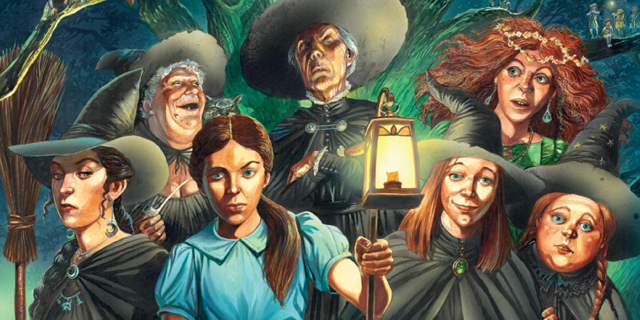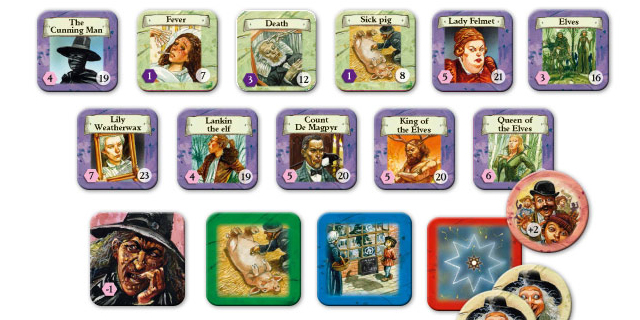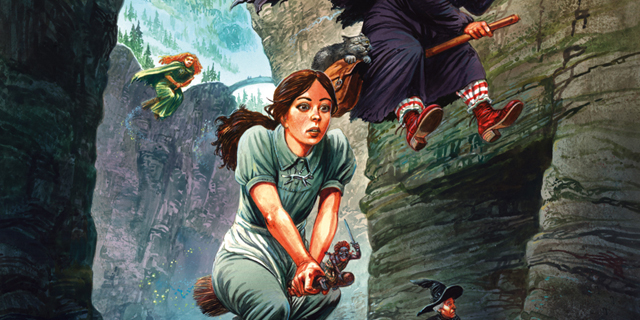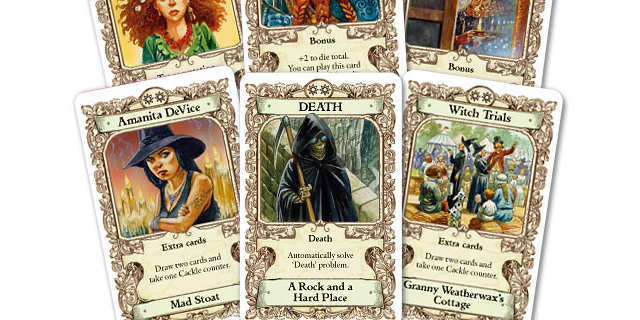
A couple of years ago I discussed a pair of Discworld-themed games that attempted to adapt Terry Pratchett’s hilarious fantasy satire universe to cardboard and wood. Of the two, I definitely felt that Martin Wallace’s Ankh-Morpork was the superior design, so I was thrilled to learn that he would be designing more games using the characters and world that I love so dearly. The second such offering, The Witches, has finally arrived. How does it stand up to its predecessor?
Honestly, the answer to that will probably depend on how big a fan you are. There is a lot going on in The Witches that makes perfect sense to experienced readers, but will come off as random or outright incomprehensible to outsiders. They can still play and enjoy the game just fine, but a lot of the resonance will be lost on them. Of course, if that gets them interested in picking up the books…
But I digress. The Witches is a semi-cooperative game putting one to four players in the role of one of the trainee witches from the Tiffany Aching sub-series, including Tiffany herself. Being a witch on Discworld is all about solving problems, whether that problem be a sick sheep, a broken limb or an invasion of Elves. At the beginning of the game, ten normal problems and five hard ones will be assigned to various towns in the kingdom of Lancre, then stacks of problems will be placed on the timer track. At the start of each turn, a card is drawn from the deck and a new problem placed on the indicated town. The game will end at the end of the turn in which the last problem is placed, assuming the players haven’t lost before that happens.

You see, if there is already a problem in the town drawn, then that problem instead becomes a Crisis and a new card is drawn, with this process repeating until a new problem is finally placed. Should the supply of Crisis markers ever run out, the players will lose, although thankfully there is a one-Crisis-per-problem limit (with some exceptions). Solving a problem both gives points to the player who does so and, if that problem was a Crisis, returns that marker to the supply.
After the new problem is placed, a player gets two actions. On each action they can move one or two spaces, although they are not allowed to move through a space occupied by a problem or another player. Depending on what else is on their space after moving, the player can then either attempt to solve the problem, have tea or do nothing. Note that this is part of the same action, not a separate action. You move and solve twice each turn, although it is easy to misread the rules and think otherwise.
Each problem has a difficulty rating ranging from seven to 23, plus two if it’s a Crisis. When attempting to solve a problem, a player first rolls two custom six-sided dice. These dice are numbered from two through six, with the one being replaced by a “cackle” result; cackles are both zeroes and dangerous, as they indicate the player’s mind becoming a little unhinged from stress. If the supply of cackle token runs out, you instead take one from the player with (or tied for) the most. If you are that player, instead you take a Black Aliss token, each of which will cost you a point at the end of the game.

After rolling the first two dice, players may then play cards from their hand (featuring just about everyone to ever appear in a “Witches of Lancre” book, including the elder witches like Granny Weatherwax and company) to improve their chances. Alternately, if a player doesn’t like their chances after the first roll, they may choose to run away from the problem and end their action after retreating to an adjacent unoccupied space (if none are present, take a cackle token and move to a non-adjacent one). If they continue, the second two dice are rolled. If the total of all four dice plus cards and other bonuses meets or exceeds the problem’s target number, the problem is solved and the player places it on their player board for both end-game scoring and for experience.
Every two normal problems grants the player a boost to maximum hand size, while every two hard problems bestows a permanent bonus +1 when solving any problem for the rest of the game. Failure, on the other hand, inflicts cackling and forces a retreat. Against some hard problems there will be an additional consequence of failure, so be sure you’re ready before facing them.
Cackles are nuisances that will really throw off your plans, but with the right cards in hand you can still solve most (normal) problems even if you roll four of them. Without the cards backing you up you often just have to do your best. That said, you can’t be afraid of gaining them if you want to get things done without effectively wasting an action. Fortunately you can get rid of cackles by having tea with other witches. Ending an action on a space occupied by another player lets you shed three cackles and everyone else on that space sheds two. Sadly, there is no getting rid of Black Aliss tokens so be sure to clear your head before you slip off down that dark path.

At the end of your turn, you draw back up to your maximum hand size, which starts off at three. The natural flow of the game is to solve several normal problems first to boost your hand size, which will then give you the edge you need to take on the hard stuff. Bear in mind that hard problems are face down until a player tries to solve them, so be prepared for anything. Whoever has the most points from solving problems at the end of the game wins, although there are alternate rules provided if you want the game to be a true co-op (solitaire play uses these rules as well).
With its emphasis on dice rolls and card draws, The Witches isn’t nearly as strategic as Ankh-Morpork, but isn’t without its charm. The fact that the Tiffany Aching books are considered “young adult” reading probably had an influence on the difficulty level here as well, as The Witches is far better suited to family play than Ankh-Morpork. A session will usually be complete in about an hour. Other than its lighter-than-expected strategy, my only problem with The Witches is the beautiful map of Lancre that serves as the game board. While its aesthetics are certainly pleasing, finding specific towns on it is kind of a pain. Some sort of grid system would have been nice here, even if it detracted from the overall feel. But overall I consider The Witches another success from Wallace, and I can’t help but wonder what else he has in store for Discworld fans (although I hope it involves Death).
The Witches: A Discworld Game retails for around $50.



















